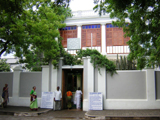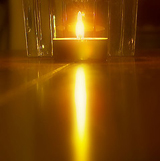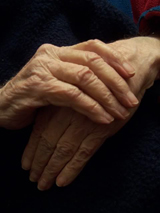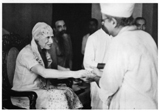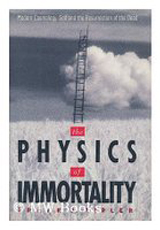Soul
The ever-present encounter with the soul — infirmities challenges and end of life
My experiences at Desirée
Abstract
Through a series of actual one-to-one encounters with infirm ashramites at Desirée, a Sri Aurobindo home for elderly ashramites at Pondicherry, India, a psychoanalyst shares her experiences, observations and reflections and the delight, grace and healing power of a soul-guided approach to human caring, both for herself as caregiver and the individuals she is attempting to serve.
Introduction
A few months before another much anticipated pilgrimage to Pondicherry to experience the ever-emanating presence of Sri Aurobindo and the Mother, I had this persistent inner prompting that while there I should work with the older, infirm ashramites in one of the Ashram homes. I had never before visited any of their facilities nor had any idea how they were organised or structured. I nonetheless put out my yearnings to a very kind person in Pondicherry, who wisely advised me to wait and see how I felt when I arrived. This was indeed a wise suggestion because the voice of the soul can often be misread, misinterpreted and confused amongst the myriad of voices that inhabit our inner consciousness. However, a continued strong inner pull, over time, is usually a good sign that the calling is indeed the voice of the soul.
When I finally did arrive in Pondicherry for a two-week stay, the prompting was still persistent so I proceeded with my request. I was introduced to Dr. Alok Pandey, who after getting permission from the relevant persons, invited me to join him on one of his several daily rounds at Desirée.
Desirée is a beautifully maintained care facility, dedicated exclusively to the care of ashram inmates needing some kind of assistance in their everyday chores. During that initial round, Dr. Pandey quickly introduced me to the 30 plus residents housed there, adding a brief relevant comment on a few. He was very cordial and accommodating and as we parted he simply said, “Come as you like when convenient and spend as much time as you like.”
I left Desirée that first day feeling exhilarated, moved and yet a bit perplexed. There was a certain amount of initial confusion and uncertainty. I had listened to the soul’s call and now, having been graciously granted the opportunity to do this work, how was I to proceed? How was I to carry it out? What precisely did I hope to do and in what manner? The residents in this facility represented such a varied population, with a wide range of challenges and capabilities, from highly functioning to end-of-life. How could I structure an approach that would work for each of them?
After sitting with the confusion for a while, a clarity emerged, suggesting that the way I could best serve this very varied population was to attempt to connect with their souls, their psychic being, to something in their depths, each in their own very unique way. The task was to find that bridge, that door, that entry-point, most accessible to each one, whether through music, a caress, a hug, stroking a hand, asking about their story, sharing a beautiful scent, sharing the beauty of a flower, speaking about the Mother and Sri Aurobindo or reading a line from Savitri.... I would need to envision and experiment with a very unique approach, custom-tailored for each.
Having reached this place of clarity in direction, it then became quite joyful to think of specific ways to potentially ignite that spark, make that connection, touch their soul that was so visibly present, speaking behind their glance, their eyes, their body language, their smile and even their reticence.
I later recognised that this approach was not novel but actually one I have tried to employ in my work in the consulting room. It is always an ongoing crucial first step to ascertain at what level of consciousness the individual is presently indwelling. To ask the question, how can I reach and connect with him or her at whatever level they are, at the moment? How do I meet them where they are, forge a connection so that trust might develop, so that the greater work of transformation through a connection with the psychic being can ensue?
“A psychic entity is there behind these occult activities which is the true support of our individualisation; the ego is only an outward false substitute: for it is this secret soul that supports and holds together our self-experience and world-experience; the mental, vital, physical, external ego is a superficial construction of Nature. It is only when we have seen both our self and our nature as a whole, in the depths as well as on the surface, that we can acquire a true basis of knowledge (1).”
Encounters
One of the very first residents who caught my attention was M. She carried a regal and tenacious presence even though her fragile body was now mainly reduced to skin and bones. I later learned that she was an old-time ashramite who would shortly be celebrating her 89th birthday and that the Mother herself had given her that name. M has been lying flat on her back for nearly five years, not uttering a word for most of that time. She was, however, quite clear on how to communicate her preferences, clenching her jaw tight when the staff attempted to feed her porridge, but accepting milk freely when it was offered. When I first approached her, she appeared reticent and unwilling to connect, clearly communicating even in the midst of her silence. Behind that veil of silence, however, stood ever so visibly, the soul of a refined, present, alert and accessible being.
On my second visit, her guard was gently loosening and I could see a trace of a sparkle in her eye and a more relaxed trust. By the third day, her guard had totally dissolved, replaced by a warm, welcoming and trusting presence. We forged a strong bond and subsequently, immediately upon seeing me, she would fix her gaze into my eyes, forever, unwaveringly, and smile from time to time. I would stroke her face and head without breaking our gaze. As I stroked the crown of her head, I would mentally convey to her the message that she could give herself permission to move on, if and when, she felt it right to do so and to remember to exit from this place.
When I arrived, often her fists would be tightly clenched shut. I would gently press my index and middle fingers into her clenched fist loosening her grip and she would respond by relaxing her fingers as I stroked her beautifully elongated hand. Each subsequent encounter was an experience of delight and I would joyfully anticipate seeing her again the next day, mentally envisioning or orchestrating what I might do or bring to deepen that connection, to bring her another small experience of joy. Whatever small effort I made was returned a thousand times by the joy that the encounter sparked.
While visiting her for the last time before I left, I sensed I might not see M again in this bodily incarnation. I wished I could be there for her at that very important moment of transition. There are many ways that one can assist another during those very sacred moments. I shall cherish the memories of my time spent with M forever.
On the opposite side on the spectrum, relative to levels of infirmities, was S, a highly functioning middle-aged man suffering from chronic fatigue. One could see, simply from how he laid out his few worldly possessions, that this was a man who brought mindfulness, order and care to everything he did. (One can often see the totality of a personality in a single gesture, just like a whole landscape can be reflected in a single dewdrop.)
S was the ultimate gentleman. Each time I arrived, I would ask him, how are you? He would immediately respond by bringing the conversation to quotes of the Mother or Sri Aurobindo and I would marvel at his devotion. Each visit, however, would evolve to this same end-point, very quickly. After a few visits I said, “I truly appreciate your knowledge and certainly your devotion to Sri Aurobindo and the Mother, but for the moment, I’d really like to know a bit about you. How are you? How is it for you to be here?” He looked at me rather perplexed. But slowly he started to open up about his personal experiences, beginning by telling me about the structure of his day. He began his day with a 4:30 wake-up call followed by his bath-time. As he continued to share his personal story, an ease and aliveness seemed to come over him. After a few visits, I noticed he started placing an empty chair, positioned right in front of his, anticipating our daily chat. As we sat there, I would at times clasp his hands in mine as he shared his story. This I sensed was likewise foreign to him but he quickly became comfortable with the joy of touch and presence.
One of the things that I continue to grow in understanding and appreciation of is the gift of Presence. It is that state of soulful, pure, non-judgmental, undivided attention to the other. When we are there for another, wholly — in body, mind, spirit and soul —such an encounter is whole, holy, healing and an ultimate gift. It provides the ground from which souls can commune. In those moments, I felt our souls did in fact reside somewhere on common and holy ground. In parting, S gifted me a beautiful blank journal, inside which he had tucked three small sweet photos of the Mother. This is a man owning no worldly possessions, save his few cherished books. I was deeply moved.
Another striking personal encounter was with A. During our quick initial walkthrough, Dr. Pandey mentioned that this was a woman who had suffered a very dark chapter in her past and that the Mother herself had taken her in as a young woman, as well as her daughter, and that A has been here at the Ashram ever since.
When I would first see her upon arriving, I would often find her twitching, especially in her lower extremities and she would often be bouncing up and down on the bed, lifting her entire fragile body off the bed and collapsing it forward, with her outstretched fingers touching her toes. This she would repeat again and again. I would gently approach her, stoke her arm and head and face, simply repeating the mantra, “Relax, relax, relax”. Then I would ask her to join me in reciting the word, “Relax”, which she would, in a gentle whisper. After holding her previously clenched fist for a short while, stroking her and inviting the energy of relaxation to come over her, one could see a beautiful calm descend over her face, her body and her entire being.
Situated in another area, at the far end back-room, was a man whose face reflected the innocence of a beautiful young boy. His face radiated with an ethereal glow and his curled lips suggested a joyous inner peace. He too, like M, did not speak and the few times I stopped to be with him he was holding a book in his hands, at times upside down. Yet every time, tucked in his book was a photo of the Mother. When I reached out to gently stroke his arm, he responded with automatic recoil. Touch, at this moment, at this point of our relationship, was not something he could embrace. His body-language clearly conveyed his inner state, a preference, I could certainly respect. I was reminded of one of the key principles of Aikido, a form of martial art, which relies heavily on the ‘Art of Not Doing’. Rather, it teaches specific techniques to simply move out of the way so that the outcome can have the least negative impact. The act of not doing can at times be the most powerful, the most effective and the most generous, vis-à-vis, the myriad of things we think we need to do or want to do.
Knowing what the soul needs at every moment, in an ever-shifting landscape, is a creative process, full of challenges and possibilities.
The very first resident Dr. Pandey had introduced to me was Daisy. Daisy was not her actual name, but a name that could perfectly suit her. On our first meeting and during a few subsequent visits, she appeared cheerful and sunny and her smile and pigtails certified her inner joy. Daisy has an androgynous cultural look about her. On first meeting her, one could not easily ascertain her ethnicity, either from her outer appearance or from her accent. In this initial work of attempting to connect with the soul of another, understanding the other’s cultural and historical influences (as best as one can, for one can never intellectually know the other completely) gives one a clue as to how and where one might connect, where the bridges and points of entry might lie. On a broader level, I believe that even in the world of psychology, politics, mediation, etc., cultural differences are a most important aspect, often not given enough import, yet it is a factor that greatly shapes the way one sees and experiences the world.
On subsequent visits to Desirée, especially in the late afternoons, I could find a much more sombre Daisy. Once I found her half sitting up, grasping her bedside railing, deep in a conversation with herself. She did not appear willing to engage and so I asked her, would she prefer having alone time? She nodded in a ‘Yes’ gesture. Daisy appeared to be reliving a piece of her personal history, perhaps replaying an emotionally impacting event from the past. I cannot say for sure. I had known Daisy for such a short time and I had no factual history of her past. I was, however, reminded that the rich threads of memories and personality traits that construct our reality in all stages of life were ever-present, even in dementia. Perhaps in her moments of intimate dialogue, Daisy was engaged in some deep inner work of releasing, at the subconscious level? We don’t know for sure what Daisy’s experience was or the deeper working of the psyche. But I do believe it is fair to say, that we must allow room for a myriad of possibilities and a trust in the infinite intelligence of the soul.
This brings me to the last resident’s story I shall share here and if we were to invite the mythic imagination to spring forward from its other worldly realms, one could envision her as the spiritual Lover of Tagore. The first time I saw LT, she was leisurely stretched out on her bed, softly singing lines from a handwritten notebook. She appeared deeply engrossed in her inner world, so I felt it completely untimely to disturb her. Instead, I struck up a conversation with her sister, whose bed stood immediately across from her chanting sister’s. She spoke of LT’s condition, describing her memory-loss and how little could be done to reverse this debilitating mental degeneration. During a subsequent visit, I was able to connect with LT and asked if she was willing, at a later stage, to sing for us a few of Tagore’s poems put to music. The following day she was fully prepared for the invitation. Four of us circled around her in that large sunlit room listening, in quiet attentiveness, as she transported us on the wings of her voice, singing beautifully a few Rabindra sangit.
Serious loss of memory, I have often thought, is one of the most debilitating, challenging and difficult losses to experience and bear witness to. And yet, here I was forced to pause and question and reconsider this mostly universally-held belief. Here was someone who could enter and inhabit fully, deeply and meaningfully the world of Tagore. Was this perhaps a more gratifying and soulful space to inhabit than what we may call, normal reality?
This statement is in no way meant to make light of all the pain and disorientation that dementia and other types of memory-loss bring, not excluding the practical, physical, emotional, psychological and social losses and pain. But in bearing witness to LT, in that moment, one is brought to ask the question, what deeper layer of experience might be there below the pain and suffering?
Reflections
During my stay in Pondicherry, I found myself referring to the residents of Desirée as my friends, both in speaking to others and in my own inner self-talk. Why had I chosen to call them friends? Perhaps because my heart understood that there was no hierarchical division between them and me, that we were in essence fellow spiritual beings, simply in different places and at different points in time on our journey? Perhaps because they were ashramites and beautiful souls who had devoted their entire lives to a calling and service. Perhaps because these were beings whose souls were awake, ones who I could easily forge an intimate connection with and call ‘Friend’.
Later I wondered, why had there been such a deep soul-yearning to do this work? Was it because of a life-long fascination with the mystery and beauty of both death and birth? Was it my own recent health issues that had plunged me into a process of reflection and meditation that had ultimately made my relationship with death and dying more intimate and accepting? Was it because of the nature of my work, where the emphasis is always on one’s own personal work? Was I following a personal and professional mandate to explore my own inner depths so that I could be of greater service? Whatever the ultimate or combination of motives, I was very grateful to have had the prompting and the trust, even when the path or the final destination was not at all clear.
Yet, I was ever so cognisant of how much more could have been done. There were still so many individuals that I had not connected with. Stories I had not heard. Histories I had not gathered. I was also keenly aware that my contribution, in relationship to the entire playing out of this soul-enriching encounter at Desirée, was such a very small part. So many supporting conditions were in place to allow my small contribution to take root.
Desirée is housed in a beautiful three-storey Gothic-inspired building with a soaring ceiling and flooded with light. The quarters are spotless, fresh smelling and spacious. Residents who cannot feed themselves are individually hand-fed. Those who cannot bathe themselves are bathed and oiled frequently. I noted and appreciated the exchanges of affection and care between the residents and the care-providers. I was keenly aware and thankful to all of them for their difficult and tireless work. Without this foundational prerequisite work, whether physical, environmental, medical or emotional, then the effort of soul-tending, which we were attempting to enhance, could not have been possible.
The American psychologist, Abraham Maslow expounds in his Humanistic Psychology that an individual rises to higher and higher levels of satisfaction and well-being when the lower-rung human foundational needs have already been met. For example, in order to arrive at psychological well-being, such as the feeling of belonging and the joy of close relationships, then basic needs, such as food and shelter, must be satisfied. The levels ascend up to self-fulfilment through self-realisation and transcendence. The Mother not only fully understood the value of this premise but applied it years earlier to Her broader work of community building. She structured an ashram at Pondicherry where all individual needs are taken care of. This she believed would allow the individual to devote himself to the greater work of a psycho-physical and spiritual evolutionary transformation in keeping with one’s true nature. Similarly, all was in place at Desirée for my small effort to take root. I was exceptionally grateful to the Sri Aurobindo Ashram for their trust and willingness to so graciously accommodate my request.
The experience at Desirée continues to pay forward with ongoing memories, reflections, contemplations and meditations. One of those musings is on our cultural collective vision of old age. It is often said that in old age, there is a return to infancy. Like children, in old age, there may be a loss of control of bodily functions, an inability to speak, feed or care for oneself, a lack of coherence and logical thinking. But what I also noticed is that in this later stage of life there is often, also, a beautiful return to innocence. Many of the qualities that we cherish in children, like spontaneity, a deep desire to connect, a willingness to share, to be present, to be held and tenderly touched are likewise, there, in this later phase of life. What if we were to outpour to this population the same joy and self-sacrifice we do to our infants and children?
Why this return to Innocence in old age? Perhaps the spirit is no longer hidden, masked by our strong, fixed ego-identity? Perhaps the Divine is preparing us for a return to our origin? Perhaps the soul is finally free to allow its light to more easily shine forth? Perhaps we are being given the opportunity to complete some evolutionary work we have chosen to carry out in this lifetime?
“...this inmost entity also, taking form in us as the psychic Person, puts forward a psychic personality which changes, grows, develops from life to life; for this is the traveller between birth and death and between death and birth, our nature parts are only its manifold and changing vesture (2).”
Yet, if there is such soul and innocence behind the veneer of aging, death and dying, why do we, generally speaking, shun away from it all? And here I am referring more to the West in general and to the USA in particular. Why do we in the USA, for example, spend billions in grasping onto youth? Why is there such a desire to look, feel and act, forever young? Why is there this feisty irreverence, a certain level of denial towards death and a false sense of immortality? Typically, funeral rituals in the USA echo this same theme. Corpses are embalmed and faces made up beautifully, hair fashioned, woman’s nails painted, etc. At times the dead body looks more attractive than the person did in decades. All of this is not so much to criticise or lay judgment on these rites and rituals, but to ponder a bigger question, what have we lost in this process of desperately holding on to youth?
Are we denying ourselves the grace and beauty that these later years of life might offer? Are we unable to peer through the door of wisdom to see the end of one evolutionary life-chapter that is giving way to the opening of another? Are we running away from death and in so doing remaining gripped by fear? When we look into the eyes of a gravely ill person, are we in pain not so much for the other, but because we see mirrored there our own inevitable physical demise? Has this fear and denial cut us off from ourselves and subsequently cut us off from our fellow human beings? Are we so blinded by unprocessed fear that we are unable to see past it, unable to connect with the eternal indwelling soul that stands before us in the aged and the dying?
“The inconscient world is the spirit’s self-made room,
Eternal Night shadow of eternal Day.
Night is not our beginning nor our end;
She is the dark Mother in whose womb we have hid
Safe from too swift a waking to world-pain.
We came to her from a supernal Light,
By Light we live and to the Light we go (3). ”
Parting note
My time at Desirée was a deep and lasting experience that gifted me with sparks of connections that bore witness to the blossoming of deeper and beautiful moments and the forging of relationships. When the conditions are created for souls to commune, there is such beauty and aliveness.
This brings to mind one of Rumi’s poems:
“Out beyond ideas of wrongdoing and rightdoing,
There is a field. I’ll meet you there.
When the soul lies down in that grass,
The world is too full to talk about.
Ideas, language, even the phrase each other
Doesn’t make any sense (4).”
In reaching out and touching the beautiful souls at Desirée, my Friends, they rewarded me in return a thousand-fold, gifting me with moments that were moving and fulfilling, opening up the heart to feelings of joy, expansion and love, allowing the “soul to lie down in that grass.”
References
1. Sri Aurobindo. Birth Centenary Library, Volume 18. Pondicherry: Sri Aurobindo Ashram Trust, 1970, p. 523.
2. Ibid., p. 225.
3. Sri Aurobindo. SABCL, Volume 29. Pondicherry: Sri Aurobindo Ashram Trust, 1970, p. 601.
4. Rumi J. The Essential Rumi. (Translation by Coleman Barks). Edison, NJ: Castle Books; 1995, p. 36.
Dorathea Thompson is an integrative psychoanalyst in private practice in
New York City.
Share with us (Comments,contributions,opinions)
When reproducing this feature, please credit NAMAH,and give the byline. Please send us cuttings.


